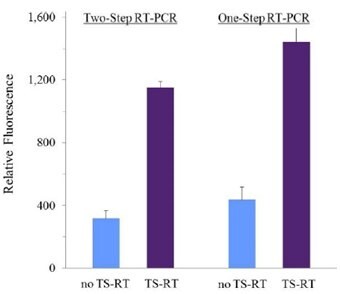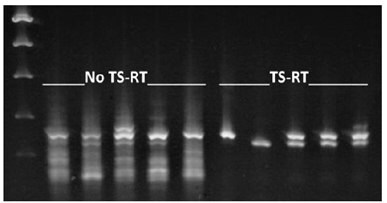ThermaStop™-RT PCR Additive
Improved RT-PCR Sensitivity, Specificity, and Product Yield
The ThermaStop™-RT additive is a simple-to-use reagent for one-step or two-step reverse transcription-PCR (RT-PCR) initiated with gene-specific primers. ThermaStop™-RT additive interacts with reverse transcriptase at low temperatures to reduce priming errors that lead to non-specific products. By eliminating these errors, the ThermaStop™-RT additive significantly increases the yield of the desired specific products and increases assay sensitivity.
How to Use:
One unit of ThermaStop™-RT additive is defined as the amount required for optimal performance in RT-PCR samples containing 50 units of reverse transcriptase and one unit of hot start Taq polymerase in a volume of 20 μL and a reverse transcription temperature of 50 °C.

Figure 1 - The ThermaStop™-RT additive greatly increases probe signals for detecting Hepatitis C Virus (HCV) RNA sequence using either two-step or one-step RT-PCR.

Figure 2 - The ThermaStop™-RT additive dramatically reduces non-specific amplification in one-step RT-PCR. Five samples without and five samples with ThermaStop™-RT show (left to right) amplification of the mitochondrial nad5 mRNA from coconut palm leaves, synthetic coconut palm viroid RNA, or coamplification of both nad5 mRNA and one of three serial dilutions of the viroid RNA. Only the specific 152 and 127 base pair products are detected in samples with the ThermaStop™-RT additive. Samples without the reagent have lower levels of those products and high levels of non-specific product. Bands on the left are from a quantitative DNA ladder (100-500 base pairs).
For Two-Step RT-PCR
Typical 20 μL cDNA synthesis mixture:
- Mix the first 5 components before adding primers and RNA template. Primers and RNA template can be prepared in a separate mixture with the RT buffer and incubated at an appropriate annealing temperature, if desired, before mixing with other components.
- Incubate cDNA synthesis mixture at 50 °C or higher for 15-30 minutes, or 45 °C for 30-60 minutes, then 95 °C for 2 minutes.
- Dilute aliquots of the cDNA sample 4- to 10-fold with PCR reagent mixture and perform thermal cycling as usual.
For One-Step RT-PCR
Typical 20 μL sample:
- It may be necessary to test a range of ThermaStop™-RT additive concentrations (e.g. 0.5 to 4 units) for RT-PCR kits containing unknown Units of reverse transcriptase. The ThermaGo™ additive should not be used with one-step RT-PCR.
- Mix the first 6 components before adding primers and RNA template. Primers and RNA template may be prepared in a separate mixture with the RT-PCR buffer and incubated at an appropriate annealing temperature, if desired, before mixing with other components.
- Incubate mixture at 50 °C or higher for 15-30 minutes, or 45 °C for 30-60 minutes, then 95 °C for 2 minutes and a thermal cycling protocol appropriate for the primers and buffer conditions.
Applications of Interest
The ThermaStop™-RT additive improves reverse transcription of virtually any RNA target. It is particularly useful in detecting low-copy targets or in assays that include multiple primer pairs (multiplexing). The ThermaStop™-RT additive has been tested with reverse transcriptases derived from MMLV and is likely to work with other RNA-dependent DNA polymerases.
How to Prepare for Use
The ThermaStop™-RT additive is shipped as a dry reagent in 250 or 1250 unit quantities and does not contain magnesium, dNTPs, or buffer components. Centrifuge tube briefly to insure the dried reagent is at the bottom of the tube. Add sterile, molecular grade 10 mM Tris, pH 8.3 in a volume to provide a final stock concentration of 5 Units/μL. Vortex 1-2 minutes, then centrifuge briefly. Allow tube to sit at room temperature for 15 minutes with occasional mixing to ensure reagent is completely dissolved.
Recommended Storage
Stock solution should be refrigerated (4 °C) or frozen (-20 °C). Aliquot into smaller volumes as necessary to avoid freezing and thawing more than 5 times.
Results to Expect
The ThermaStop™-RT additive will generate higher yields of the specific products (e.g. stronger probe signals, specific bands on gels) and less non-specific products compared to samples without the ThermaStop™-RT additive. The reagent should also improve detection of RNA targets at a much lower concentration.
如要继续阅读,请登录或创建帐户。
暂无帐户?